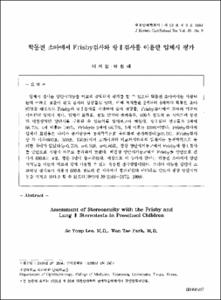학동전 소아에서 Frisby검사와 랑 II 검사를 이용한 입체시 평가
- Keimyung Author(s)
- Lee, Se Youp
- Department
- Dept. of Ophthalmology (안과학)
- Journal Title
- 대한안과학회지
- Issued Date
- 1998
- Volume
- 39
- Issue
- 9
- Abstract
- The evaluation of stereoacuity provides relatively accurate assessment of binocular function. However, it is difficult to perform and also the success rate is low in preschool children. We investigated the success rate, the difference in stereoacuity between crossed and uncrossed disparities in the Frisby test, the rate of demonstrating stereopsis, the presence of monocular cue and, whether at the level of 600 arcsec of stereoacuity by performing the Frisby and Lang II stereotest can differentiate between normal and abnormal binocular vision in preschool to 6-yearᅳold children. The success rate of the Lang I stereotest was 66.1% in 2-year-old children and 100% in children over 4 years old. The success rate of the Frisby stereotest was 66.1% in 2-year—old children and 100% in children over 5 years old. It was statistically significant that the rate of demonstrating stereopsis increased with the patient's age(p<0.01). In the Frisby test, the difference in stereoacuity between the crossed and uncrossed diaparities was not statistically significant at each disparities (600", 300", 150") (p=0. 700, p=0.926 and p=0.866) . No study subject passed the stereotests with normal binocular vision when examined monocularly with the Frisby and Lang II stereotests. When children with abnormal binocular vision were examined binocularly with the Frisby and Lang II stereotests, 4 children passed at 600 arcsec in the Frisby test and 3 children passed in the Lang II test (600" or 400"). With these results, Frisby and Lang II stereotests were considered easily available and valuable test for evaluating binocular vision in preschool children. However, if a child is passed either at 600 arcsec of the Frisby or Lang II as screening test, we do not regard that he or she has normal binocular vision.
입체시 검사는 양안시기능을 비교적 정확하게 평가를 할 수 있으나 학동전 소아에서는 시행하는데 어려운 점들이 많고 검사의 성공률도 낮다. 이에 저자들은 2세부터 6세까지 학동전 소아 87명을 대상으로 Frisby와 랑 II검사를 시행하여 검사 성공률,Frisby검사에서 교차와 비교차 시차간의 입체시 차이,입체시 표현율, 한눈 단서의 존재유무, 600초 정도의 큰 시차로써 정상 과 비정상적인 양안시를 구분할 수 있는지를 알아보고자 하였다. 랑 II검사 성공률은 2세에 66.1%, 4세 이후는 100%, Frisby는 2세에 66.7%, 5세 이후는 100%이었다. Frisby검사의 입체시 표현율은 나이가 증가할수록 통계학적으로 유의하게 증가하였다(p<0.01). Frisby검사 상 각 시차(600초,300초, 150초)에서 교차시차와 비교차시차와의 입체시는 통계학적으로 유 의한 차이가 없었다(p=0.700, p=0.926, p=0.866). 정상 양안시기능군에서 Frisby와 랑 II검사 를 단안으로 시행시 아무도 통과하지 못했다. 비정상 양안시기능군에서 Frisby를 양안으로 검 사시 600초는 4명,랑은 3명이 통과하였다. 이상으로 이 두가지 검사는 학동전 소아에서 양안 시기능을 아는데 비교적 쉽게 사용될 수 있는 유용한 검사방법이었다. 그러나 이들을 양안시 스 크리닝 검사로서 사용시 600초 정도의 큰 시차에서 통과되었다 하더라도 반드시 정상 양안시기 능을 가지고 있다고 할 수 없겠다.
- Alternative Title
- Assessment of Stereoacuity with the Frisby and Lang II Stereotests in Preschool Children
- Keimyung Author(s)(Kor)
- 이세엽
- Publisher
- School of Medicine
- Citation
- 이세엽 and 박원태. (1998). 학동전 소아에서 Frisby검사와 랑 II 검사를 이용한 입체시 평가. 대한안과학회지, 39(9), 2165–2172.
- Type
- Article
- ISSN
- 0378-6471
- Appears in Collections:
- 1. School of Medicine (의과대학) > Dept. of Ophthalmology (안과학)
- 파일 목록
-
-
Download
 oak-bbb-02704.pdf
기타 데이터 / 543.83 kB / Adobe PDF
oak-bbb-02704.pdf
기타 데이터 / 543.83 kB / Adobe PDF
-
Items in Repository are protected by copyright, with all rights reserved, unless otherwise indicated.